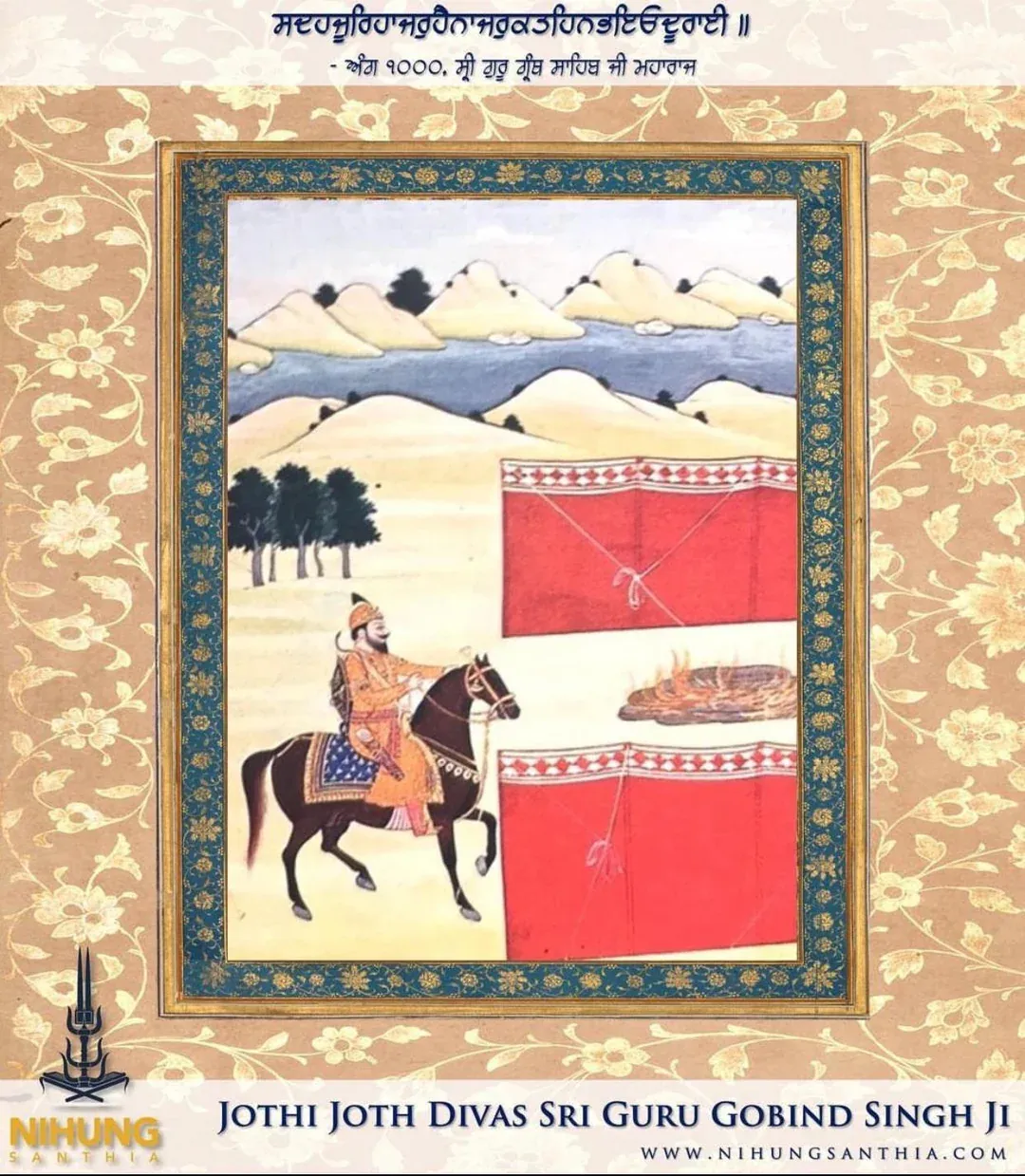20th Doharaa: 'Bisikh BaaN Dhhanukhaagar Bhan...'
Dhan Dhan Kalgidhar Maharaj, Chittey Baja Wale Paatshah, Neela-Ghorh Asvaar, Sarbans Daani, Dasmesh Pita Ji Sri Guru Gobind Singh Sahib Ji Maharaj
-
ਬਿਸਿਖ ਬਾਨ ਧਨੁਖਾਗ੍ਰ ਭਨ ਸਰ ਕੈਬਰ ਜਿੱਹ ਨਾਮ ॥
Bisikh Baan Dhhan[u]kh-aagr Bhan Sar Kaibar Jih naam
ਤੀਰ ਖਤੰਗ ਤਤਾਰਚੋ ਸਦਾ ਕਰੋ ਮਮ ਕਾਮ ॥੨੦॥
Theer Khatha[n]g Thathaarcho Sadhaa Karo Mam Kaam
-
ਰਾਮਕਲੀ ਮਹਲਾ ੫ ॥
Raam-kalee Mahalla Panjvaa
Dhan Dhan Sri Guru Arjan Dev Sahib Ji Maharaj in Raag Ramkali
ਕੋਈ ਬੋਲੈ ਰਾਮ ਰਾਮ ਕੋਈ ਖੁਦਾਇ ॥
Koee Bolai Raam Raam Koee Khudhaa-i
Some say Raam-Raam, some say Khudhaa
ਕੋਈ ਸੇਵੈ ਗੁਸਈਆ ਕੋਈ ਅਲਾਹਿ ॥੧॥
Koee Saevai Gus-aeeaa Koee Alaah-i
Some serve Gosai and some say Allah
(Ang 885)
-
Why are we speaking about the Names of Vaheguru in the middle of the Shastar Naam Mala? We can’t forget that this is Gurbani. Dhan Dhan Sri Guru Gobind Singh Ji Maharaj are giving their Sikhs spiritual teachings in the middle of warrior teachings. This shines light on the surface of how deep Gurbani can be. -Vaheguru Ji have many names but still are One. We can look at this example of the relationships of a woman and how one person can be seen in many ways. For her husband, she is called ‘wife’; for her son/daughter she is called ‘mother, for her parents she is called ‘daughter’, for her grandchildren, she is ‘grandmother’; for her siblings, she is ‘sister’; for her sibling’s children, she is called ‘aunt’... in the same way, Vaheguru Ji are called by different names based on their relationships. In the case of all humans, we may call Vaheguru Ji different names based on our languages.
-
In this particular Dohara, Guru Sahib keep referring to different names for one thing: the arrow. Some words may have other meanings but are still tied to archery e.g. also used as a name for the bow or a specific type of arrow. The emphasis on archery that Guru Maharaj have featured in this Doharaa can allow us to focus on many aspects of archery. There is a spiritual teaching which can be remembered every time someone practices archery.

In the 5th Ruth of Sri GurPratap Suraj Prakash Granth, the Singhs ask Dhan Dhan Sri Guru Gobind Singh Ji about Karma. Guru Maharaj command Pyare Bhai Daya Singh Ji to answer this. Bhai Daya Singh Ji use an analogy of archery to explain to the Sangat. We have taken this [edited] translation excerpt from Manglacharan.com :
... ਕਰਮ ਬਾਣ ਬਾਸਾ ਨਿਤ ਪ੍ਰਤਿ ਲਹਿਂ । ਜੋ ਤਰਕਸ਼ਤੇ ਤੀਰ ਨਿਕਾਰਾ ।
ਐਂਚਿ ਧਨੁਖ ਛੁਟਿ ਚਲ੍ਯੋ ਅਗਾਰਾ ।17।
...Karam BaaN Baasaa nith Prath[i] Lah[in]; Jo Tharkashthae Theer nikaaraa; Ai[n]ch Dhhanukh Chhut[i] Chalyo Agaaraa
... Karma as different types of arrows, they are always within the quiver. If one shoots an arrow from one's bow, that arrow leaves the bow and travels forward. ਅਪਨੋ ਬੇਗਸੁ ਸਭਿ ਹੀ ਕਰਿਕੇ । ਨਿਸ਼ਫਲ ਹੋਤਿ ਰਹੈ ਧਰ ਪਰਿਕੇ ।
ਪਰਾਰਬਧ ਹੈ ਯਾਂਕੋ ਨਾਮ । ਦੇ ਫਲ ਸਭਿ ਕੋ ਹੋਇ ਵਿਰਾਮ ।18॥
Apano Baegas[u] Sabh[i] Hee Karikae; nishphal Hoth[i] Rahai Dhhar Parikae;
Paraarbadhh Hai Yaa[n]ko naam; Dhae Phal Sabh[i] Ko Hoe[i] Viraam
That arrow, with its speed and velocity, falls on the floor missing its aim, fruitlessly. This arrow is called Praalabadhh, this gives its fruit and then becomes irrelevant.
ਥਿਰ ਤਰਕਸ਼ ਮਹਿਂ ਜੇਤਿਕ ਬਾਨ । ਤਿਨ ਕੋ ਸੰਚਿਤ ਨਾਮ ਬਖਾਨ ।
ਧਨੁਸ਼ ਜੇਹ ਸੋਂ ਜੋਰ੍ਯੋ ਜੋਇ । ਨਾਮ ਸੁ ਕਿਰੇਮਾਨ ਤਿਸ ਹੋਇ ।19।
Thhir Tharkash Mah[in] Jaethik Baan; Thin Ko Sa[n]chith naam Bakhaan;
Dhhanush Jaeh So[n] Joryo Joe[i]; naam Su Kiraemaan This Hoe[i]
All the arrows in the quiver, these arrows are called Sanchit Karams. Kriyaman Karam's are those arrows which are held to the string of the bow ready to fire.
ਜਿਨ ਕਰਮਨਿ ਕੋ ਦਿਯੋ ਸਰੀਰ । ਪਰਾਰਬਧ ਸੋ ਜਾਨਹੁਂ ਧੀਰ ।ਅਨਿਕ ਜਨਮ ਕੇ ਕਰੇ ਇਕੱਤ੍ਰ । ਸੋ ਸੰਚਤਿ ਹੈਂ ਨਾਮ ਬਚਿੱਤ੍ਰ ।20।
Those Karma's which give one their birth/body in this life, these are called Praladh Karams. Those karams, which are accumulated over countless lifetimes, these endless varieties of karams are called Sanchit Karam.
ਕ੍ਰਿਆ ਹੋਤਿ ਨਿਤ ਜੁਤਿ ਅਭਿਮਾਨ । ਕਿਰੇਮਾਨਏ ਜਾਨ ਸੁਜਾਨ ।
ਕਿਰੇਮਾਨ ਜੋ ਕਹ੍ਯੋ ਬਨਾਇ । ਤ੍ਰੈ ਸੰਗ੍ਯਾ ਇਸਕੀ ਹੁਇ ਜਾਇਂ ।21।
The daily actions taken with the ignorance of duality, wise ones recognize these types of Karma as Kiryamaan. The Karma that is called Kiryamaan has three variations that relate to the three aspects of time.
ਪ੍ਰਥਮ ਅਵਸਥਾ ਮਹਿਂ ਕਿਰੇਮਾਨ । ਦੁਤੀਏ ਮਹਿਂ ਸੰਚਤਿ ਇਹ ਜਾਨ ।
ਤ੍ਰਿਤੀ ਅਵਸਥਾ ਜਬਿ ਹੀ ਪਾਇ । ਪਰਾਰਬਧ ਸੰਗ੍ਯਾ ਹੁਇ ਜਾਇਂ । 22।
Prathham Avasthaa Mah[in] Kiraemaan; Dhuthee-ae Mah[in] Sa[n]chith Ih Jaan; Thrithee Avasthhaa Jab[i] Hee Paae[i]; Paraarabadhh Sa[n]gyaa Hue[i] Jaae[in]
The first state is called Kiryamaan, the second is called Sanchit, and the third state - which is born from the previous two - is called Praarabdh Karma.
ਜਿਮ ਇਕ ਕਾਲ ਭਵਿੱਖਤ ਹੋਇ । ਬਹੁਰੋ ਬਰਤਮਾਨ ਹੈ ਸੋਇ ।
ਸੋਈ ਕਾਲ ਭੂਤ ਹ੍ਵੈ ਜਾਇ । ਲਖਹੁ ਖਾਲਸਾ ਤਿਸ ਹੀ ਭਾਇ ।23।
Jim Ik Kaal Bhavikhath Hoe[i]; Bahuro Barthmaan Hai Soe[i];
Soee Kaal Bhooth Hvai Jaae[i]; Lakhah[u] Khaalsaa This Hee Bhaae[i]
Just like the phases of time, how the future becomes the present, and the present becomes the past, Khalsa understand this to be analogous to the state of Karma.(5th Ruth, Manglacharan.com)

For anyone who is learning archery as part of Maharaj’s 52 bachans: #30: ‘To practice Shastar Vidhya and Horsemanship’, there are many aspects of archery to learn about and one of them is the draw method. This varies depending on which region you go. Some people use their fingers to pull the bowstring and others use the thumb.

During the time when Guru Sahib took on human form, it was common practice for royal archers to wear thumb rings used for drawing arrows with their thumbs (generally, horse-mounted archery). Traditionally, South Asia also used finger draws. So for the Sikh, any means of archery would be following the Puratan Khalsa. There are also many categories of bows too.
-
When one reaches an intermediate state of archery, they can learn about the follow-through process after the arrow is released. These follow-through processes include moving the bow forward or away from the arrow upon releasing the bow. There is something called khatra (not pronounced like the punjabi word khathra/danger) where the archer moves their arm away from the arrow once released. Here is a video that can help understand a few types of release:
Please check out more archery videos by Armin HIrmer for detailed instruction
Even within Sri Guru Granth Sahib Ji's Gurbani, there are many references to arrows but not always using the word. Here are few examples with quite profound teachings:
ਦ੍ਰੁਮ ਕੀ ਛਾਇਆ ਨਿਹਚਲ ਗ੍ਰਿਹੁ ਬਾਂਧਿਆ॥
Dhrum Kee Chhaaeiaa nihchal Grih[u] Baa[n]dhhiaa
Knowing it to be permanent, one builds their house (and other aspects of life)
but it is impermanent like the shade of a tree
ਕਾਲ ਕੈ ਫਾਂਸਿ ਸਕਤ ਸਰੁ ਸਾਂਧਿਆ॥੨॥
Kaal Kai Phaa[n]s Sakath Sar[u] Saa[n]dhhiaa
In the noose of death, torn by the arrows of Maya (Vaheguru's Manifestation/Creation)
(Dhan Dhan Sri Guru Arjan Dev ji Maharaj in Raag Aasaa, Ang 390)
In these panktiya, Guru Maharaj are using arrows to describe the dangers of the mind planning life based on the temporary pleasures of the five senses. These pleasures don't last and so, life goes wasted
-
ਪ੍ਰੇਮ ਕੇ ਸਰ ਲਾਗੇ ਤਨ ਭੀਤਰਿ ਤਾ ਭ੍ਰਮੁ ਕਾਟਿਆ ਜਾਈ॥੧॥
Praem Kae Sar Laagae Than Bheethar[i] Thaa Bhram[u] Kaatiaa Jaaee
When the arrows of love come and hit the inside of the body,
then our wrong perceptions are cut away
(Dhan Dhan Sri Guru Ramdaas Ji Maharaj in Raag Soratt, Ang 607)
In this pankti, Guru Maharaj are describing an experience of Prema Bhagti (Divine Love). When one falls in love with Vaheguru then they start to lose the incorrect way of seeing the world which in turns saves the human from lots of pain. These arrows of love hit the heart and tears come with them. These strong feelings can only be described as being hit by an arrow!
-
ਘੋੜਾ ਕੀਤੋ ਸਹਜ ਦਾ ਜਤੁ ਕੀਓ ਪਲਾਣੁ॥
Ghorraa Keethaa Sahaj Dhaa jath[u] KeeO PalaaN[u]
Guru Sahib have mounted the Horse of Sahaj (Steady Peace resulting from Spiritual Realization/Bliss)
while sitting on the Saddle of Restraint (of the Senses)
ਧਣਖੁ ਚੜਾਇਓ ਸਤ ਦਾ ਜਸ ਹੰਦਾ ਬਾਣੁ॥
DhhaNakh[u] CharraeiO Sath Dhaa Jas Ha[n]dhaa BaaN[u]
Guru Sahib drawing the Bow of Reality/Spiritual Truth and place the Arrow of Divine Praises (describing the Qualities of Vaheguru
(Ramkalee Kee Vaar, Ang 968)
Found in the beginning of Ramkali Ki Vaar, Bhai Satha Ji & Bhai Balvand Ji start their praise of our Guru Sahibaan by explaining how they get ready for the spiritual war against Kalyug!

When Dhan Dhan Sri Guru Gobind Singh Ji Maharaj left their physical body (Jyothi-Jyothi), even at that time, there was archery involved! At this time, Guru Maharaj had an assassination attempt by two Pathans. Guru Maharaj had a physical wound which was stitched up by an alleged European doctor. After some time, the wounds healed internally. One day, a craftsman had offered a luxurious and large bow for Guru Maharaj. Some nobles in Guru Maharaj's Darbar noticed and remarked that the bow doesn't seem like it could actually be pulled (that it was purely for show purposes). Guru Maharaj heard this and immediately pulled the bow. Their Strength is so powerful that at the time, both ends of the bow touched each other. With such force, the wound re-opened. Guru Maharaj announced to the Sangat that They will not treat the wound and it is time for Their Jyothi Jyoth (Summarized from Gurbilas Patshahi Dasveen and referred to in Pavithar Jeevan {Mata Sahib Devan Jeevani})
The Sikhs had become very emotional and could not bear being away from Guru Maharaj in Their Physical Form:
ਅਬਿਨਾਸੀ ਤੇਰੀ ਹਾਸੀ ਹਮੈ ਗਾਸੀ ਸੀ ਲਗਤ ਹੈ॥੫੨॥
Abinaasee Thaeree Haasee Hamai Gaasee See Lagath Hai
Oh Indestructible Vaheguru, Your Play feels like an arrow for us
(Sri Krishna Avatar)
The one practice of archery has many components to it. We have covered various aspects of it here. Vaheguru Ji are the One who created archery and the one who wields the bow. Vaheguru Ji are the Karta Purakh (The Doing Being), all tasks are done through Vaheguru. Vaheguru Ji hold the Bow of Their Maya Shakti and are letting out Kirpa arrows which create, sustain, and destroy. May the Warrior be able to get the Divine Vision of the Saint.
-
Please forgive any mistakes! Suggest any additions or omissions
Guru Panth Ka Daas,
Aaeenaa

